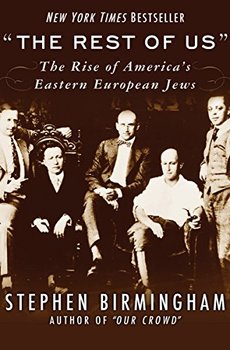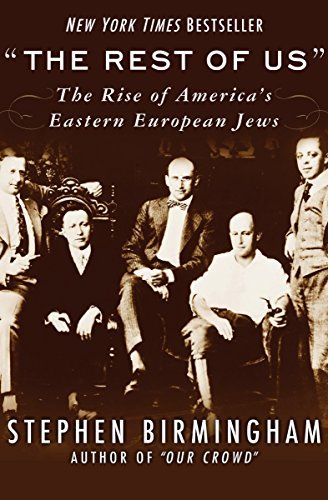
Some of the most remarkable figures in the history of the United States during the first half of the twentieth century were first- or second-generation Jews who had emigrated from the Russian Empire. The social historian Stephen Birmingham (1929-2015) told their colorful story in “The Rest of Us” more than forty years ago. But his account remains as lively and engaging as ever today. If you want to understand the history of Jews in America, this is the place to start.
Jews have emigrated to the United States in three distinct waves:
Sephardic Jews
Beginning in 1654, a small group of Sephardic Jews landed in what was then New Amsterdam, having fled from Brazil when the Portuguese reconquered the country. Others followed in later years, settling in eastern coastal cities from Newport, Rhode Island, to Savannah, Georgia. Although they were influential in later years, the Sephardic community was small and was greatly outnumbered by the later-arriving Ashkenazi Jews from northern and eastern Europe.
“The Rest of Us”: The Rise of America’s Eastern European Jews by Stephen Birmingham (1977) 434 pages @@@@ (4 out of 5)
German-speaking Jews
Some 150,000 Jews emigrated to the United States in the period 1820 to 1880, the majority of them German-speaking Jews (many of whom had not lived in Germany proper). By the late nineteenth century, the German-Jewish community had acquired wealth and influence, giving rise to many of the great mercantile fortunes and some of the most powerful firms on Wall Street. Some of their names remain famous to this day: Guggenheim, Loeb, Lehman, Morgenthau, and Warburg, among others.
Eastern European (“Russian”) Jews
Over the period 1880 to 1920, 2.8 million Jews landed in the United States. The overwhelming majority had been subjects of the Russian Empire, which then included most of today’s Poland, Ukraine, the Baltic states, and much of eastern Europe. Already “by 1906,” Birmingham notes, “nearly two million Jews—roughly a third of the Jews of Eastern Europe—had left their homes.” And nearly all of them eventually arrived in the United States.
In “The Rest of Us,” Birmingham centers his story on the decades-long cultural and religious tension between the “German” and “Russian” Jews who had flocked to America in the nineteenth and early twentieth centuries. Reading this book was a very personal experience for me, as my father’s family arrived at Ellis Island in 1901, having escaped a pogrom in Russia. My mother’s father landed in New York twenty years earlier, part of the last of the wave of “German” Jewish immigrants. However, I failed to notice any evidence of the tension between the two camps about which Birmingham wrote so eloquently.

A long list of extraordinary individuals
Birmingham tells his story through the lives of some of the most remarkable individuals among the millions of Eastern European Jewish immigrants. There are especially detailed portrayals of several:
- Hollywood producer Samuel Goldwyn (Shmuel Gelbfisz)
- labor activist Rose Pastor Stokes
- radio and television pioneer David Sarnoff
- cosmetics magnate Helena Rubinstein (Chaja Rubinstein)
- songwriter Irving Berlin (Israel Beilin)
- Meyer Lansky (Meier Suchowlański) and other Jewish mobsters
- fashion icon Ralph Lauren (Ralphie Lifshitz)
- liquor titan Samuel Bronfman
A great many other still-well-known names crop up in passing. The author’s account is especially strong in his discussion of the Jews who rose to prominence in show business, the garment industry, the fur and jewelry businesses, and organized crime.
“The Rest of Us” does not pretend to be a comprehensive story of Jews in America. Rather, it’s an impressionistic account that traces the trajectory through life of a small number of especially interesting individuals, often against fierce resistance from the “German” Jews who had preceded them to these shores. For a hint of the attitudes that permeated the German-Jewish community, consider this remark Birmingham quotes from one prominent member of its Old Guard: “But those Bronfmans,” she said, “have just come down from the trees.”
The resentment isn’t hard to understand. As Birmingham explains, “It had taken the Germans two and in some cases three generations to reach their status of wealth and almost assimilation. It had taken the Russians barely one.”
For further reading
To understand what drove millions of Polish and Russian Jews to emigrate, see Pogrom: Kishinev and the Tilt of History by Steven J. Zipperstein (In a prelude to the Holocaust, the Kishinev pogrom shocked the world).
And for the American reaction to the flood of Eastern European immigrants early in the twentieth century, see The Guarded Gate: Bigotry, Eugenics, and the Law That Kept Generations of Jews, Italians, and Other European Immigrants Out of America by Daniel Okrent (The racist movement that stopped immigration a century ago).
For a fascinating, in-depth treatment of the life of Rose Pastor Stokes, read Rebel Cinderella: From Rags to Riches to Radical, the Epic Journey of Rose Pastor Stokes by Adam Hochschild (Early 20th-century America viewed through the life of one extraordinary woman).
You might also be interested in:
- More than 25 worthy books about Jewish topics
- 15 good books about the Holocaust, including both fiction and nonfiction
- Top 20 popular books for understanding American history
And you can always find my most popular reviews, and the most recent ones, plus a guide to this whole site, on the Home Page.



























